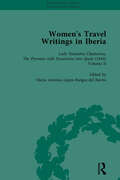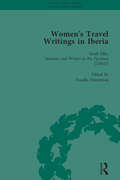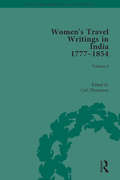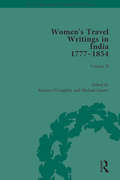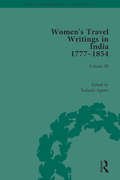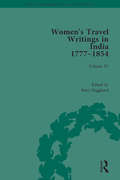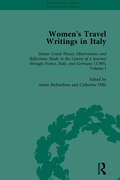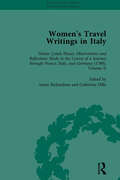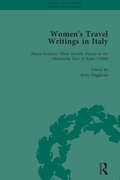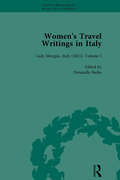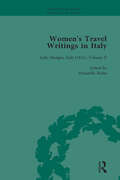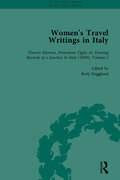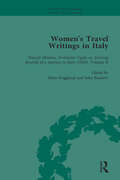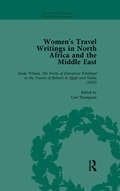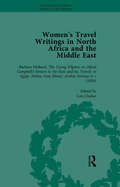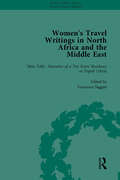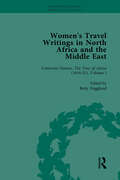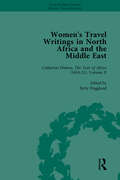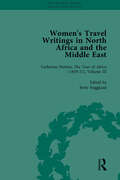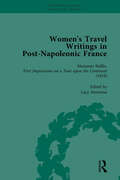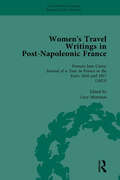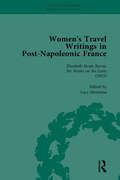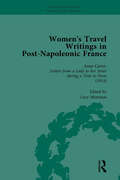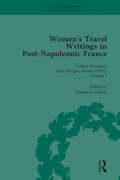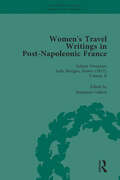- Table View
- List View
Women's Travel Writings in Iberia Vol 4
by Stephen Bending Stephen Bygrave Eroulla Demetriou Jose Ruiz Mas Maria Antonia Lopez-Burgos del BarrioLisbon and the Pyrenees form the basis of this lively collection of firsthand accounts of travel within Portugal and Spain in the early nineteenth century.
Women's Travel Writings in Iberia Vol 5
by Stephen Bending Stephen Bygrave Eroulla Demetriou Jose Ruiz Mas Maria Antonia Lopez-Burgos del BarrioLisbon and the Pyrenees form the basis of this lively collection of firsthand accounts of travel within Portugal and Spain in the early nineteenth century.
Women's Travel Writings in India 1777–1854: Volume I: Jemima Kindersley, Letters from the Island of Teneriffe, Brazil, the Cape of Good Hope and the East Indies (1777); and Maria Graham, Journal of a Residence in India (1812) (Chawton House Library: Women’s Travel Writings)
by Carl ThompsonThe ‘memsahibs’ of the British Raj in India are well-known figures today, frequently depicted in fiction, TV and film. In recent years, they have also become the focus of extensive scholarship. Less familiar to both academics and the general public, however, are the eighteenth- and early nineteenth-century precursors to the memsahibs of the Victorian and Edwardian era. Yet British women also visited and resided in India in this earlier period, witnessing first-hand the tumultuous, expansionist decades in which the East India Company established British control over the subcontinent. Some of these travellers produced highly regarded accounts of their experiences, thereby inaugurating a rich tradition of women’s travel writing about India. In the process, they not only reported events and developments in the subcontinent, they also contributed to them, helping to shape opinion and policy on issues such as colonial rule, religion, and social reform. This new set in the Chawton House Library Women’s Travel Writing series assembles seven of these accounts, six by British authors (Jemima Kindersley, Maria Graham, Eliza Fay, Ann Deane, Julia Maitland and Mary Sherwood) and one by an American (Harriet Newell). Their narratives – here reproduced for the first time in reset scholarly editions – were published between 1777 and 1854, and recount journeys undertaken in India, or periods of residence there, between the 1760s and the 1830s. Collectively they showcase the range of women’s interests and activities in India, and also the variety of narrative forms, voices and personae available to them as travel writers. Some stand squarely in the tradition of Enlightenment ethnography; others show the growing influence of Evangelical beliefs. But all disrupt any lingering stereotypes about women’s passivity, reticence and lack of public agency in this period, when colonial women were not yet as sequestered and debarred from cross-cultural contact as they would later be during the Raj. Their narratives are consequently a useful resource to students and researchers across multiple fields and disciplines, including women’s writing, travel writing, colonial and postcolonial studies, the history of women’s educational and missionary work, and Romantic-era and nineteenth-century literature. This volume includes 2 texts, Jemima Kindersley, Letters from the Island of Teneriffe, Brazil, the Cape of Good Hope, and the East Indies (1777) and Maria Graham, Journal of a Residence in India (1812).
Women's Travel Writings in India 1777–1854: Volume II: Harriet Newell, Memoirs of Mrs Harriet Newell, Wife of the Reverend Samuel Newell, American Missionary to India (1815); and Eliza Fay, Letters from India (1817) (Chawton House Library: Women’s Travel Writings)
by Michael Gamer Katrina O’LoughlinThe ‘memsahibs’ of the British Raj in India are well-known figures today, frequently depicted in fiction, TV and film. In recent years, they have also become the focus of extensive scholarship. Less familiar to both academics and the general public, however, are the eighteenth- and early nineteenth-century precursors to the memsahibs of the Victorian and Edwardian era. Yet British women also visited and resided in India in this earlier period, witnessing first-hand the tumultuous, expansionist decades in which the East India Company established British control over the subcontinent. Some of these travellers produced highly regarded accounts of their experiences, thereby inaugurating a rich tradition of women’s travel writing about India. In the process, they not only reported events and developments in the subcontinent, they also contributed to them, helping to shape opinion and policy on issues such as colonial rule, religion, and social reform. This new set in the Chawton House Library Women’s Travel Writing series assembles seven of these accounts, six by British authors (Jemima Kindersley, Maria Graham, Eliza Fay, Ann Deane, Julia Maitland and Mary Sherwood) and one by an American (Harriet Newell). Their narratives – here reproduced for the first time in reset scholarly editions – were published between 1777 and 1854, and recount journeys undertaken in India, or periods of residence there, between the 1760s and the 1830s. Collectively they showcase the range of women’s interests and activities in India, and also the variety of narrative forms, voices and personae available to them as travel writers. Some stand squarely in the tradition of Enlightenment ethnography; others show the growing influence of Evangelical beliefs. But all disrupt any lingering stereotypes about women’s passivity, reticence and lack of public agency in this period, when colonial women were not yet as sequestered and debarred from cross-cultural contact as they would later be during the Raj. Their narratives are consequently a useful resource to students and researchers across multiple fields and disciplines, including women’s writing, travel writing, colonial and postcolonial studies, the history of women’s educational and missionary work, and Romantic-era and nineteenth-century literature. This second volume includes two texts, Harriet Newell, Memoirs of Mrs Harriet Newell (1815) and Eliza Fay, Original Letters from India (1817).
Women's Travel Writings in India 1777–1854: Volume III: Mrs A. Deane, A Tour through the Upper Provinces of Hindustan (1823); and Julia Charlotte Maitland, Letters from Madras During the Years 1836-39, by a Lady (1843) (Chawton House Library: Women’s Travel Writings)
by Éadaoin AgnewThe ‘memsahibs’ of the British Raj in India are well-known figures today, frequently depicted in fiction, TV and film. In recent years, they have also become the focus of extensive scholarship. Less familiar to both academics and the general public, however, are the eighteenth- and early nineteenth-century precursors to the memsahibs of the Victorian and Edwardian era. Yet British women also visited and resided in India in this earlier period, witnessing first-hand the tumultuous, expansionist decades in which the East India Company established British control over the subcontinent. Some of these travellers produced highly regarded accounts of their experiences, thereby inaugurating a rich tradition of women’s travel writing about India. In the process, they not only reported events and developments in the subcontinent, they also contributed to them, helping to shape opinion and policy on issues such as colonial rule, religion, and social reform. This new set in the Chawton House Library Women’s Travel Writing series assembles seven of these accounts, six by British authors (Jemima Kindersley, Maria Graham, Eliza Fay, Ann Deane, Julia Maitland and Mary Sherwood) and one by an American (Harriet Newell). Their narratives – here reproduced for the first time in reset scholarly editions – were published between 1777 and 1854, and recount journeys undertaken in India, or periods of residence there, between the 1760s and the 1830s. Collectively they showcase the range of women’s interests and activities in India, and also the variety of narrative forms, voices and personae available to them as travel writers. Some stand squarely in the tradition of Enlightenment ethnography; others show the growing influence of Evangelical beliefs. But all disrupt any lingering stereotypes about women’s passivity, reticence and lack of public agency in this period, when colonial women were not yet as sequestered and debarred from cross-cultural contact as they would later be during the Raj. Their narratives are consequently a useful resource to students and researchers across multiple fields and disciplines, including women’s writing, travel writing, colonial and postcolonial studies, the history of women’s educational and missionary work, and Romantic-era and nineteenth-century literature. This volume includes two texts, Ann Deane, A Tour Through the Upper Provinces of Hindostan (1823) and Julia Maitland, Letters from Madras (1846).
Women's Travel Writings in India 1777–1854: Volume IV: Mary Martha Sherwood, The Life of Mrs Sherwood (1854) (Chawton House Library: Women’s Travel Writings)
by Betty HagglundThe ‘memsahibs’ of the British Raj in India are well-known figures today, frequently depicted in fiction, TV and film. In recent years, they have also become the focus of extensive scholarship. Less familiar to both academics and the general public, however, are the eighteenth- and early nineteenth-century precursors to the memsahibs of the Victorian and Edwardian era. Yet British women also visited and resided in India in this earlier period, witnessing first-hand the tumultuous, expansionist decades in which the East India Company established British control over the subcontinent. Some of these travellers produced highly regarded accounts of their experiences, thereby inaugurating a rich tradition of women’s travel writing about India. In the process, they not only reported events and developments in the subcontinent, they also contributed to them, helping to shape opinion and policy on issues such as colonial rule, religion, and social reform. This new set in the Chawton House Library Women’s Travel Writing series assembles seven of these accounts, six by British authors (Jemima Kindersley, Maria Graham, Eliza Fay, Ann Deane, Julia Maitland and Mary Sherwood) and one by an American (Harriet Newell). Their narratives – here reproduced for the first time in reset scholarly editions – were published between 1777 and 1854, and recount journeys undertaken in India, or periods of residence there, between the 1760s and the 1830s. Collectively they showcase the range of women’s interests and activities in India, and also the variety of narrative forms, voices and personae available to them as travel writers. Some stand squarely in the tradition of Enlightenment ethnography; others show the growing influence of Evangelical beliefs. But all disrupt any lingering stereotypes about women’s passivity, reticence and lack of public agency in this period, when colonial women were not yet as sequestered and debarred from cross-cultural contact as they would later be during the Raj. Their narratives are consequently a useful resource to students and researchers across multiple fields and disciplines, including women’s writing, travel writing, colonial and postcolonial studies, the history of women’s educational and missionary work, and Romantic-era and nineteenth-century literature. This final volume reproduces a text by Mary Sherwood, called The Life of Mrs Sherwood (1854).
Women's Travel Writings in Italy, Part I Vol 3
by Stephen Bending Betty Hagglund Stephen Bygrave Donatella Badin Catherine DilleChawton House Library: Women's Travel Writings are multi-volume editions with full texts reproduced in facsimile with new scholarly apparatus. The texts have been carefully selected to illustrate various themes in women's history.
Women's Travel Writings in Italy, Part I Vol 4
by Stephen Bending Betty Hagglund Stephen Bygrave Donatella Badin Catherine DilleChawton House Library: Women's Travel Writings are multi-volume editions with full texts reproduced in facsimile with new scholarly apparatus. The texts have been carefully selected to illustrate various themes in women's history.
Women's Travel Writings in Italy, Part II vol 5
by Betty Hagglund Jennie Batchelor Julia Banister Donatella BadinChawton House Library: Women's Travel Writings are multi-volume editions with full texts reproduced in facsimile with new scholarly apparatus. The texts have been carefully selected to illustrate various themes in women's history.
Women's Travel Writings in Italy, Part II vol 6
by Betty Hagglund Jennie Batchelor Julia Banister Donatella BadinChawton House Library: Women's Travel Writings are multi-volume editions with full texts reproduced in facsimile with new scholarly apparatus. The texts have been carefully selected to illustrate various themes in women's history.
Women's Travel Writings in Italy, Part II vol 7
by Betty Hagglund Jennie Batchelor Julia Banister Donatella BadinChawton House Library: Women's Travel Writings are multi-volume editions with full texts reproduced in facsimile with new scholarly apparatus. The texts have been carefully selected to illustrate various themes in women's history.
Women's Travel Writings in Italy, Part II vol 8
by Betty Hagglund Jennie Batchelor Julia Banister Donatella BadinChawton House Library: Women's Travel Writings are multi-volume editions with full texts reproduced in facsimile with new scholarly apparatus. The texts have been carefully selected to illustrate various themes in women's history.
Women's Travel Writings in Italy, Part II vol 9
by Betty Hagglund Jennie Batchelor Julia Banister Donatella BadinChawton House Library: Women's Travel Writings are multi-volume editions with full texts reproduced in facsimile with new scholarly apparatus. The texts have been carefully selected to illustrate various themes in women's history.
Women's Travel Writings in North Africa and the Middle East, Part I Vol 1
by Carl Thompson Francesca Saggini Lois ChaberContinuing the series on Women's Travel Writings, this two-part collection presents some fascinating tales of North Africa and the Middle East. Part I includes three separate volumes that include the writings of Volume 1: Sarah Wilson, The Fruits of Enterprise Exhibited in the Travels of Belzoni in Egypt and Nubia (1825); Volume 2 Barbara Hofland, The Young Pilgrim, or Alfred Campbell's Return to the East and his Travels in Egypt, Nubia, Asia Minor, Arabia Petraea &c (1826); and Volume 3: 'Miss Tully', Narrative of a Ten Years' Residence at Tripoli in Africa (1816).
Women's Travel Writings in North Africa and the Middle East, Part I Vol 2
by Carl Thompson Francesca Saggini Lois ChaberContinuing the series on Women's Travel Writings, this two-part collection presents some fascinating tales of North Africa and the Middle East. Part I includes three separate volumes that include the writings of Volume 1: Sarah Wilson, The Fruits of Enterprise Exhibited in the Travels of Belzoni in Egypt and Nubia (1825); Volume 2 Barbara Hofland, The Young Pilgrim, or Alfred Campbell's Return to the East and his Travels in Egypt, Nubia, Asia Minor, Arabia Petraea (1826); and Volume 3: 'Miss Tully', Narrative of a Ten Years' Residence at Tripoli in Africa (1816).
Women's Travel Writings in North Africa and the Middle East, Part I Vol 3
by Carl Thompson Francesca Saggini Lois ChaberContinuing the series on Women's Travel Writings, this two-part collection presents some fascinating tales of North Africa and the Middle East. Part I includes three separate volumes that include the writings of Volume 1: Sarah Wilson, The Fruits of Enterprise Exhibited in the Travels of Belzoni in Egypt and Nubia (1825); Volume 2 Barbara Hofland, The Young Pilgrim, or Alfred Campbell's Return to the East and his Travels in Egypt, Nubia, Asia Minor, Arabia Petraea (1826); and Volume 3: 'Miss Tully', Narrative of a Ten Years' Residence at Tripoli in Africa (1816).
Women's Travel Writings in North Africa and the Middle East, Part II vol 4 (Chawton House Library: Women's Travel Writings)
by Betty HagglundPart II of this edition reproduces The Tour of Africa, first published in 1821 by Catherine Hutton. Although framed as a first-person narrative, the three-volume work is in fact a compilation of existing travel accounts. Hutton’s Tour raises challenging questions about intertextuality in nineteenth-century women’s travel writing.
Women's Travel Writings in North Africa and the Middle East, Part II vol 5 (Chawton House Library: Women's Travel Writings)
by Betty HagglundPart II of this edition reproduces The Tour of Africa, first published in 1821 by Catherine Hutton. Although framed as a first-person narrative, the three-volume work is in fact a compilation of existing travel accounts. Hutton’s Tour raises challenging questions about intertextuality in nineteenth-century women’s travel writing.
Women's Travel Writings in North Africa and the Middle East, Part II vol 6 (Chawton House Library: Women's Travel Writings)
by Betty HagglundPart II of this edition reproduces The Tour of Africa, first published in 1821 by Catherine Hutton. Although framed as a first-person narrative, the three-volume work is in fact a compilation of existing travel accounts. Hutton’s Tour raises challenging questions about intertextuality in nineteenth-century women’s travel writing.
Women's Travel Writings in Post-Napoleonic France, Part I Vol 1
by Stephen Bending Benjamin Colbert Stephen Bygrave Lucy MorrisonThis eight-volume set in two parts gives voice to some intrepid women travellers touring post-Napoleonic France. The volumes are facsimile editions and are introduced and edited by experts in their field.
Women's Travel Writings in Post-Napoleonic France, Part I Vol 2
by Stephen Bending Benjamin Colbert Stephen Bygrave Lucy MorrisonThis eight-volume set in two parts gives voice to some intrepid women travellers touring post-Napoleonic France. The volumes are facsimile editions and are introduced and edited by experts in their field.
Women's Travel Writings in Post-Napoleonic France, Part I Vol 3
by Stephen Bending Benjamin Colbert Stephen Bygrave Lucy MorrisonThis eight-volume set in two parts gives voice to some intrepid women travellers touring post-Napoleonic France. The volumes are facsimile editions and are introduced and edited by experts in their field.
Women's Travel Writings in Post-Napoleonic France, Part I Vol 4
by Stephen Bending Benjamin Colbert Stephen Bygrave Lucy MorrisonThis eight-volume set in two parts gives voice to some intrepid women travellers touring post-Napoleonic France. The volumes are facsimile editions and are introduced and edited by experts in their field.
Women's Travel Writings in Post-Napoleonic France, Part II vol 5
by Stephen Bending Paul Hague Benjamin Colbert Stephen Bygrave Lucy MorrisonThis eight-volume set in two parts gives voice to some intrepid women travellers touring post-Napoleonic France. The volumes are facsimile editions and are introduced and edited by experts in their field.
Women's Travel Writings in Post-Napoleonic France, Part II vol 6
by Stephen Bending Paul Hague Benjamin Colbert Stephen Bygrave Lucy MorrisonThis eight-volume set in two parts gives voice to some intrepid women travellers touring post-Napoleonic France. The volumes are facsimile editions and are introduced and edited by experts in their field.
